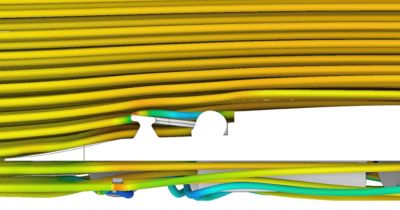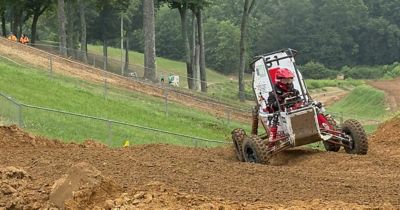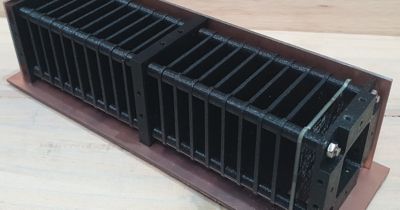-
-
Access Free Student Software
Ansys empowers the next generation of engineers
Students get free access to world-class simulation software.
-
Connect with Ansys Now!
Design your future
Connect with Ansys to explore how simulation can power your next breakthrough.
Countries & Regions
Free Trials
Products & Services
Learn
About
Back
Products & Services
Back
Learn
Ansys empowers the next generation of engineers
Students get free access to world-class simulation software.
Back
About
Design your future
Connect with Ansys to explore how simulation can power your next breakthrough.
Free Trials

In a world where everything is expected to be faster — from smart devices to mobile networks — transportation is no exception.
The TUM Hyperloop team from Germany is made up of students and researchers supervised by their respective professors from the Technical University of Munich (TUM). As one of the top hyperloop development teams in the world, TUM Hyperloop’s goal is to change lives by transforming transportation as we know it. The team was created in 2015 for the SpaceX Hyperloop Pod competition and officially took the name “TUM Hyperloop” in 2017. In the competition, student teams were charged with creating the first hyperloop pods for high speed in partial vacuum. Fast-forward to 2025, and the TUM Hyperloop team now consists of nearly 30 students and engineers and is the creator of Europe’s first hyperloop segment certified for passenger mobility. And their goal? To engineer a world without limits of distance and time.
What is Hyperloop?
The innovative hyperloop system is divided into two components. It consists of an efficient network of tubes that connect mobility centers and on-demand vehicles, called pods, that move at an average speed of 600 to 900 km/h. The original concept of the hyperloop was much different than it looks now. The only thing that has stayed the same is that it involves a tube at a low environmental pressure, between 1 and 10 millibars.
TUM Hyperloop's design features a fully magnetic propulsion system with no moving mechanical components. The pod levitates magnetically inside a vacuum-maintained concrete tube, eliminating air resistance and enabling high-speed travel with minimal drag. This design not only improves efficiency but also enhances passenger comfort. Once implemented, the complete system will comprise multiple tube segments connected over long distances, allowing passengers to travel from point A to point B in record time.
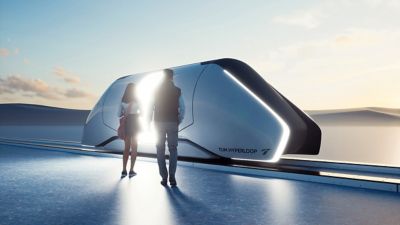
A concept photo of a TUM Hyperloop pod.
What makes TUM Hyperloop’s design different from Japanese, South Korean, or Chinese maglev systems is their passenger vehicle concept. Current-day maglev systems are very similar to trains in that they both have multiple cars. The hyperloop system is different: each pod will hold between 20 and 50 people and be connected via a network of modular hyperloop hubs, similar to train stations. In addition to the style of car, the TUM Hyperloop team’s design is also different in that it is completely climate-neutral in operation. These advancements ultimately enable the system to operate with more frequent departures than conventional trains. The omission of mechanical contact, and ultimately wear and tear on parts, also greatly reduces downtime due to maintenance.
To achieve the most accurate atmosphere for test conditions, the team created a fully scaled demonstrator to serve as a test facility for passenger transport. The demonstration has been supported by the Bavarian State Government as part of the Bavarian High-tech Agenda, an initiative that seeks to boost science innovation in the region. In July 2023, TUM Hyperloop successfully performed the first passenger ride under vacuum conditions. In the test, two passengers experienced what a ride on the hyperloop would be like from the comfort of a passenger pod.
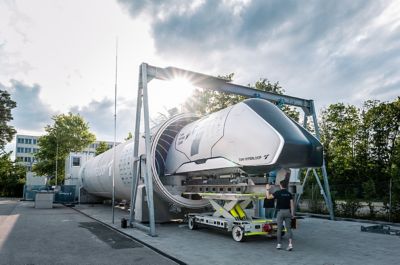
TUM Hyperloop demonstrator
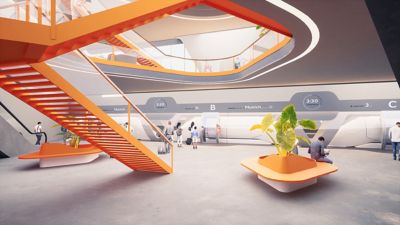
Conceptual image of the boarding zone of a hyperloop hub
Simulation Advances High-speed Transportation
We sat down with some members of the TUM Hyperloop team to learn about how they are leveraging Ansys tools, with help from an Ansys Student Team Partnership, to develop the technology for this ultra-fast, emission-free mobility network. The team has used Ansys simulation from the very beginning, according to TUM Hyperloop levitation engineer Oliver Kleikemper. “From what I heard from former colleagues, we tried a few simulation tools in the early days of the team and Ansys was the best choice … it has proven itself,” he says.
Since they began using Ansys tools, the team has relied on simulation throughout multiple disciplines within the Hyperloop design process.
Understanding Hyperloop Aerodynamics
João Nicolau, head of aerodynamics for TUM Hyperloop, explains that 100% of his team relies on Ansys simulation, mainly within Ansys Fluent fluid simulation software, along with the Ansys Fluent Meshing capability. The team also uses the Ansys Workbench simulation integration platform and Ansys Discovery 3D product simulation software for creating new conceptual designs. The ability to test the aerodynamics of the hyperloop not only saves time, but also enables the team to run tests with advanced physics modeling capabilities without the luxury of a multimillion-dollar test track.

Ansys Fluent simulation showing the number of contours of the flow in the tube around the pod with supersonic flow in a pod-fixed coordinate system.
“That's the main challenge for aerodynamics — even small tests have severe limitations. It’s very costly in both money and in time, especially time because it needs to be very well prepared. And even if very well prepared, the results are still subject to the limited information we can get,” Nicolau says.
Looking ahead, the team plans to expand its use of Fluent software by integrating its capabilities with the finite element method (FEM), which would enable simulations to update one another in real time. This would lead to a more polished, informed design and ultimately a more advanced simulation.
Simulating the Structure, Electromagnetic Levitation, and Propulsion of Hyperloop Technology
The TUM Hyperloop levitation and propulsion teams rely on Ansys Maxwell advanced electromagnetic field solver for magnetic simulation to support their research and development of their hyperloop system.
Ansys simulation plays a crucial role in controller development for the electromagnetic suspension of the pod. The team relied heavily on the precise modeling capabilities of Maxwell software to provide them with the most accurate models.

Concept study of a horizontal electromagnetic switch without moving components.
“Ansys accompanied our whole development process of the magnetic levitation system, from dimensioning the coils and magnets to studying their static and dynamic behavior,” says Kleikemper. “There has never been a big question if we should switch to another tool — it’s just very powerful.”
“There are a lot of mechanical and thermal simulations that we use Ansys for,” says Tim Hofmann, head of propulsion for TUM Hyperloop. As an example, the total mechanical deformation of the pod’s pressure vessel is shown below. The results of two construction methods are compared, where one is based on a frame with stringers, the other on a frame with rivets, also known from aircraft construction.

Frame and stringer construction of the pod's pressure vessel. A simulation of the total mechanical deformation of the structure that is connected with frames, stringers, and additional clips. (left) A comparative study on the previous implementation of the pod's pressure vessel structure, in which the aircraft construction method with rivets and frames was simulated. (right)
Leveraging CADFEM’s Expertise With Ansys Solutions
The TUM Hyperloop team works closely with CADFEM Germany, an Ansys Apex Channel Partner. CADFEM is a pioneer in the application of numerical simulation in product development and a leading computer-aided engineering (CAE) provider, supporting Ansys users with all aspects of simulation.
Through seminars and workshops, the TUM Hyperloop team has taken full advantage of its partnership with CADFEM. “[CADFEM] is just someone who supports us in case there are questions and we need support. It’s very helpful and convenient when we are having a problem or when working with a new software,” explains Hofmann.
CADFEM not only provides the team with access to Ansys software licenses but also offers direct support for implementing tools as quickly as possible, enabling the seamless and fast integration of Ansys simulation.
What’s Next for TUM Hyperloop
As the team continues to advance and test their designs for the hyperloop network, they are looking to add more complexities to their simulations. Right now, the team is running most of their designs in 2D, which is already intensive. In doing so, they are shortening simulation runtimes from weeks to days. But there is more to do. The team plans to look to 3D simulations and high-performance computing (HPC) to help them both simplify and advance their workflow even further.
In addition to someday funding and building a full-size test track, the TUM Hyperloop team remains strongly involved in research and fostering student engagement.
Connecting Europe
“The European Commission and European High-tech developments want to build the hyperloop in Europe, so we continue to cooperate with different companies around Europe [and] reach an agreement on the general design so that it can be implemented in Europe,” says Nicolau.
Hofmann explains that now, with the local government, the European Commission, and the EU looking to develop a hyperloop reference track, the team is looking to establish a research group at TUM. “A very important point is us feeding information to the scientific community to make the system possible — we do provide a lot of valuable information. “We established a group at the university that is focused on research topics,” Nicolau says.
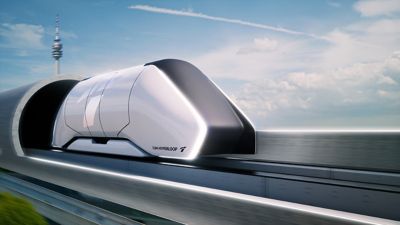
Looking to the Future of Sustainable Mobility
With the help of Ansys simulation and support from CADFEM, the TUM Hyperloop team is on their way to making the hyperloop system a reality. Through their pioneering advancements in sustainable mobility, the team is enabling more rapid transportation, greater passenger comfort, and more environmentally friendly methods to connect people faster than ever before.
See how you can power your team’s innovation with support from an Ansys Student Team Partnership.
The Advantage Blog
The Ansys Advantage blog, featuring contributions from Ansys and other technology experts, keeps you updated on how Ansys simulation is powering innovation that drives human advancement.
